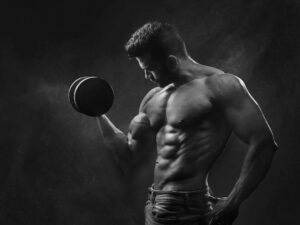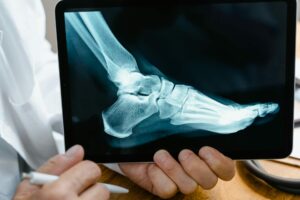Building muscle is more than just lifting weights. How do you incorporate your workouts into your daily routine? What is the best diet to put on muscle? How much water should I drink? There are a lot of questions people ask us when they are first learning how to build muscle.
The Foundation of Muscle Growth
Muscle Hypertrophy
When you workout your muscle fibers experience micro tears. This usually happens when you push your muscles past their limits during resistance or weight training. After your workout, your body uses nutrients and proteins to rebuild the muscle fibers, making them larger and stronger.
This is why what you eat and how well you sleep are just as important as the actual workouts. All are key factors to muscle growth.
Nutritional Choices
Nutrition is a cornerstone of muscle growth, providing your body the fuel to build and repair muscle fibers.
Protein is the foundation of muscle nutrition. Protein supplies the amino acids your body uses to build muscle. Try to eat 1.6 to 2.2 grams of protein per kilo of body weigh every day.
Carbohydrates provide the energy you need for workouts and training. They also help replenish glycogen after the workouts are done. Complex carbs such as fruits, whole grains and vegetables work best.
Healthy fats are needed to help support hormone production. In particular testosterone which is critical for muscle growth. Good sources of healthy fat are avocados, nuts, and olive oil.
When you eat also plays a role in how effective your muscle growth will be. Try to eat a balanced meal containing carbs and protein right after working out. This will provide the nutrients needed for your body to repair and grow new muscle.
Workout Strategies
Effective workout strategies are key to maximizing muscle growth. It’s not just about lifting weights; it’s also about how you lift those weights.
- Progressive Overload: This is when you slowly increase the weight, frequency and number of sets. This will help push your muscles to grow.
- Compound Exercises: You want to engage multiple muscle groups simultaneously. Good compound exercises for muscle growth are squats, deadlifts, and bench presses.
- Proper Form: You will get the best muscle growth results with proper form over heavier weights. Learns the proper form before you raise the weight. You will grow faster and with less risk of injury.
Pro tip: Changing up your routine can help you avoid plateaus. Keep your muscles challenged and engaged by occasionally changing exercises, reps, and rest periods.
Overlooked Parts of a Routine
A good muscle-building routine is more than lifting weights. Here are some often missed components
Hydration
Proper hydration is vital for effective muscle growth and overall fitness. Your body needs water for temperature regulation, joint lubrication and nutrient transport. If you are dehydrated, your performance is compromised. This leads to decreased strength, less energy and endurance and slower recovery. Your risk of injury is also higher. Try to drink at least 8 to 10 glasses of water every day.
While you are working out, drink water to maintain your body’s hydration. You can also drink a sports drink to help replenish lost electrolytes. If you feel thirsty, that is your body telling you it’s getting dehydrated.
After your workout, you want to rehydrate your body. This helps your body get rid of metabolic waste and also supports muscle repair and recovery. Weight yourself at the start and end of your workout and aim for 16 to 24 ounces of water for every pound lost.
Rest Days
Rest days allow your body to repair and and build new muscle. When you exercise you get micro tears in your muscle. Your rest days lets these fibers heal and grow stronger. Skipping a rest day only risks overtraining and injury which will stall your progress.
That doesn’t mean your rest day has to be inactive. Consider doing yoga or go for a walk or hike. These activities will help enhance blood flow to aid recovery. Focusing on your flexibility and mobility on rest days will help boost your performance in the gym. Aim for one or two rest days a week. Most importantly listen to your body — if you feel extra sore or fatigued, thats a sign you might need an extra rest day.
Exploring SARM Supplements
Selective Androgen Receptor Modulators (SARMs) have become popular in the gym. They selectively target the androgen receptors in specific tissues to promote muscle grown and fat loss. SARMs like Ostarine are used to retain muscle and burn fat while Ligandrol and Testolone are used for building muscle and strength.
Debunking Muscle Growth Myths
A prevalent myth is that muscles transform into fat if you stop exercising. Muscle and fat are two totally different types of tissue. If you stop exercising, it may lead to fat gain and muscle loss, but one doesn’t convert into the other.
Another myth is that you need to be sore after a workout or it wasn’t an effective workout. Soreness may indicate you have challenged your muscle fibers, but it isn’t a prerequisite. You can have a productive workout without feeling sore. We hear often that daily training gives the best results. That isn’t necessarily true, if you overtrain your body, you will halt your progress. Your muscles need time to repair and recover between workouts.
You also don’t need to eat protein immediately after you finish working out. Post-workout nutrition is important, however your overall daily protein intake is more important than the timing. Finally the myth that lifting weights will excessively bulk up a woman is wrong. Most women do not possess the testosterone levels needed for significant muscle growth without specific nutrition and training plans.









Add comment